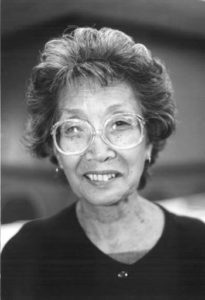
Yuri Kochiyama
*Yuri Kochiyama was born on this date in 1921. She was an Japanese-American activist and journalist.
Born Mary Yuriko Nakahara in San Pedro, Calif, she an outgoing student in high school, she played sports and wrote for the school newspaper. She was mostly unaware of political issues until her father, Seiichi, was taken into custody by the F.B.I. shortly after the Japanese bombed Pearl Harbor in December 1941. Her father a successful fish merchant, was held and interrogated for several weeks before being released on Jan. 20, 1942. He died the next day. By the spring, the rest of the family was among the 120,000 Japanese Americans sent to internment camps across the country. During World War II she spent two years in an internment camp for Japanese-Americans in Arkansas, a searing experience that also exposed her to the racism of the Jim Crow South.
A few years after the war, she married William Kochiyama, whom she had met at the camp, and the couple moved to New York in 1948. They spent 12 years in public housing in Manhattan, in the Amsterdam Houses on the Upper West Side, where most of their neighbors were black and Puerto Rican, before moving to Harlem. He had been interned in Arkansas before he joined the all-Japanese 442nd Regimental Combat Team, which became one of the most decorated units in American military history. In the 1960s and ’70s, the sofa in the Kochiyamas’ apartment was regularly occupied by activists in need of a place to sleep. Years later, Mrs. Kochiyama helped organize campaigns to free activists and others whom she believed had been wrongly imprisoned.
The couple had become active in the civil rights movement when Kochiyama met Malcolm X for the first time at a Brooklyn courthouse in October 1963. He was surrounded by supporters, mostly young black men, when she approached him. She told him “I admire what you’re doing,” she told him, “but I disagree with some of your thoughts.” He asked which ones, she said “Your harsh stand on integration.” They met, and by 1964 Kochiyama and her husband had befriended him.
Early that year Malcolm X began moving away from the Nation of Islam, toward beliefs that were accepting of many kinds of people. He sent the Kochiyamas postcards from his travels to Africa and elsewhere. One, mailed from Kuwait on Sept. 27, 1964, read: “Still trying to travel and broaden my scope since I’ve learned what a mess can be made by narrow-minded people. Bro. Malcolm X.”
The following February, Kochiyama was in the audience at the Audubon Ballroom in the Washington Heights section of Manhattan waiting to hear Malcolm X address a new group he had founded, the Organization of Afro-American Unity, when there was a burst of gunfire. She ran toward the stage. “I just went straight to Malcolm, and I put his head on my lap,” she recalled. “He just lay there. He had difficulty breathing, and he didn’t utter a word.” A photograph of her holding him accompanied an article about the assassination in the March 5, 1965, issue of Life magazine.
In the 1980s, the Kochiyamas sought government reparations for Japanese-Americans who had been interned. In 1988, Congress approved a plan to pay $20,000 to each of the estimated 60,000 surviving internees. Her husband died in 1993. She was an inspiration into the 21st century. Her life, (particularly her writings) were a contemporary example of the intersectionality of Asian and African heritage in America.
For its 2011 album “Cinemetropolis,” the Seattle hip-hop group Blue Scholars wrote a song about her. The refrain: “When I grow up I want to be just like Yuri Kochiyama.” Yuri Kochiyama, civil rights activist, friend and ally of Malcolm X died on June 1st, 2014 in Berkeley, Calif. She was 93.